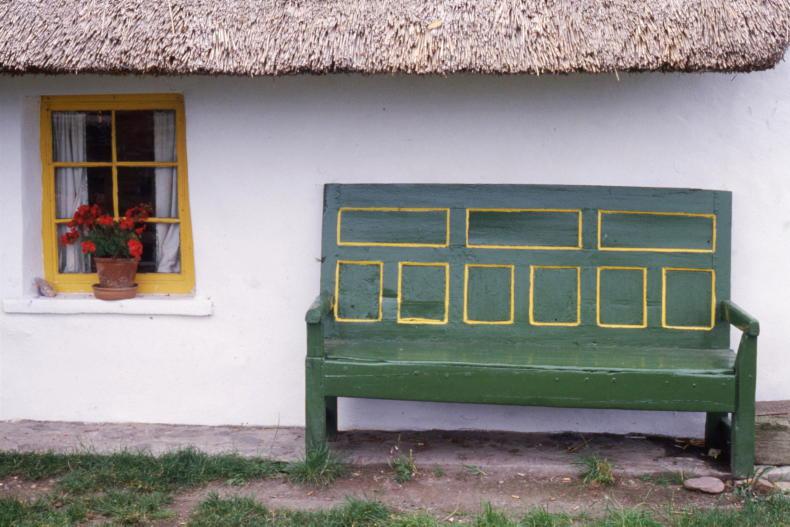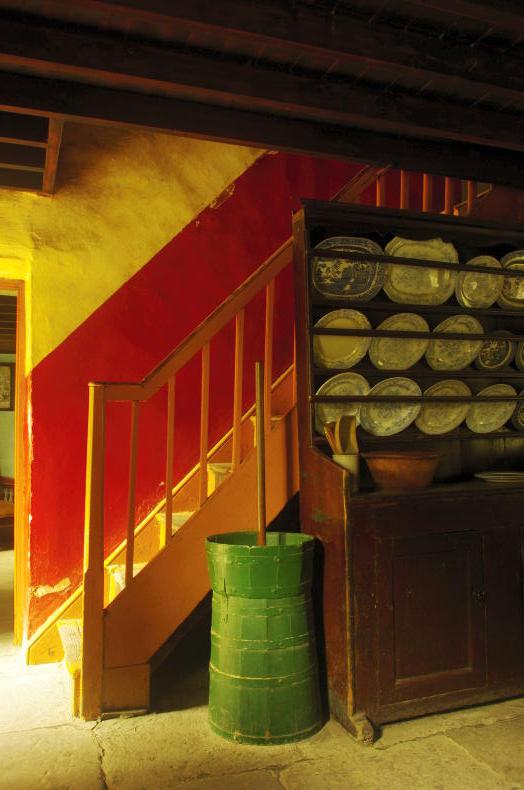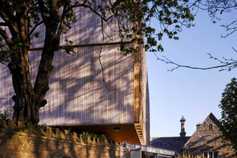Claudia Kinmonth is an author and design historian living in Skibbereen, Co Cork. Growing up in London, she spent her holidays in west Cork with her father’s family.
Claudia explains how she yearned for the Cork countryside as a child.
“I thought life in west Cork was the bee’s knees,” she says. “I was miserable whenever I went back to London; I remember bursting into tears as we left.

Glazed dresser painted pale blue and yellow, near Leap, Co Cork, c 1930.
“I finally managed to move to Cork 22 years ago. We brought our children up here and it’s just the place to live.”
Holidays in west Cork
As Claudia recalls her days in Cork, her passion of place is evident.
“My father bought a cottage in west Cork so we could all come and stay, be close to the grandparents and all the Irish cousins. I loved the freedom of running around outside, jumping on and off ponies and horses, being in the farmyards, chasing the pigs – you know, really like a farmer’s child.”
One of Claudia’s fondest memories of her childhood in rural Ireland were trips to the local creamery.

An early carpenter's chair made primarily of pine, near Glandore, Cork, c 1830-40.
“The creamery was just fascinating,” she says. “It was like a swimming pool with everybody pouring their churns in. You’d have to stay there for an hour or two and there was a little shop that sold Fox’s Glacier Mints, white bread and Tayto crisps. Everyone was very friendly and the creamery was very much a community thing as everyone knew each other.
“Those farmers don’t get together anymore in that same way and I think it was very important for the community,” she adds.
Claudia recognised the stark contrast between city and country life from a young age, explaining the informality she experienced from life in Cork was something she didn’t often experience in England.
“It’s hard to encapsulate, but I was blissfully happy [as a child in west Cork].”

An open-frame pine settle, Crosshaven, Co Cork, c1800.
Career
Claudia originally worked in furniture restoration. During her earlier years, while learning the practicalities of the job, she got her first taste of Irish furniture while working for an Irish employer in London.
Her interest sufficiently piqued; she went on to study furniture restoration and conservation, and then completed her MA in the history of design at the Royal College of Art, followed by a PhD in Irish vernacular furniture.
Irish country furniture

Claudia recently published
Irish Country Furniture and Furnishings 1700-2000, which focuses on farmhouse and cabin furniture. It is a continuation of a similar book published in 1993; following research done as part of her thesis.
She says the economy and Celtic Tiger years, in particular, saw a significant shift in traditional Irish homes toward the end of the 20th century. With a sense of urgency (at the idea of historic objects being disused or thrown away), she embarked in fieldwork in 1988; knocking on farmhouse doors and enquiring about old furniture.
“When I looked at a dresser, I wanted to know who had made it, who it was made for and whether it was made for a tiny house or a big house,” she explains. “I thought I’d find that out by discovering those who still had these pieces in their houses.”
Claudia recalls the hospitality she was met with on her visits around the country.

Late 19th century partition dresser.
“The loveliest part of my work was going into farmhouses and finding things still in kitchens and talking to people about the furniture they have kept and loved,” she reminisces. “Once I was inside and they started to discuss things, they were very hospitable and it was often very difficult to leave. Then, they’d start to lay the table and give me the most amazing feasts.
“It was lovely getting to know people,” she continues. “I’d go back to visit them and there would be much more information the second time, because they had been talking about me and my work after I’d left.”
New book
In 2015, Claudia received a research fellowship in the Moore Institute, NUI Galway, which enabled her to start writing a new edition of her book. She wanted her research to reach a new generation, while sharing her archives in the process.
“All those photographs I had taken in the 1980s are important now,” she says. “Many of the houses I visited are gone and many owners have died. The Celtic Tiger came along and really swept away the older, unmodernised houses.
“The aim of this book was to publish those interesting early pictures but also all the new material I had discovered through my research in Galway over the last five or six years.”

Green dash churn for making butter and archetypal Ulster dresser, in Coshkib Farmhouse. \ Ulster Folk Museum
Irish Country Furniture and Furnishings 1700-2000 investigates farmhouse and cabin furniture sourced in rural Ireland and the information these pieces provide us about our ancestors.
With over 450 illustrations and photographs, Claudia’s book goes far beyond the appearance of furniture. She also explores the social and cultural history of generations gone by.
With chapters dedicated to different pieces, the text explores a number of areas including traditional architecture, timber shortages, painting and decoration – each revealing something different about how Irish people lived.

Noggins were used for eating and drinking. \ National Museum of Ireland
Claudia’s newer edition is more detailed than the first; featuring an additional 130 illustrations with revised and updated information. The black and white photos used in her previous publication have been improved or replaced with colour versions.
Functional Furniture
From her years of research, Claudia commends the ingenious nature of previous generations.
“Nothing was just for show,” she explains. “Every piece of furniture had a function.”
The versatility of antique furniture found in Irish farmhouses reveals a lot of about our ancestors. “People were very frugal and they were very good at using materials carefully,” Claudia concludes.
“Our ancestors were not only ingenious with lots of dual-purpose designs, but it also showed that they didn’t waste anything.
www.claudiakinmonth.ie
Discount code
Readers can avail of 20% off the price list for Claudia’s book at www.corkuniversitypress.com using the promotional code ICF.
Claudia Kinmonth is an author and design historian living in Skibbereen, Co Cork. Growing up in London, she spent her holidays in west Cork with her father’s family.
Claudia explains how she yearned for the Cork countryside as a child.
“I thought life in west Cork was the bee’s knees,” she says. “I was miserable whenever I went back to London; I remember bursting into tears as we left.

Glazed dresser painted pale blue and yellow, near Leap, Co Cork, c 1930.
“I finally managed to move to Cork 22 years ago. We brought our children up here and it’s just the place to live.”
Holidays in west Cork
As Claudia recalls her days in Cork, her passion of place is evident.
“My father bought a cottage in west Cork so we could all come and stay, be close to the grandparents and all the Irish cousins. I loved the freedom of running around outside, jumping on and off ponies and horses, being in the farmyards, chasing the pigs – you know, really like a farmer’s child.”
One of Claudia’s fondest memories of her childhood in rural Ireland were trips to the local creamery.

An early carpenter's chair made primarily of pine, near Glandore, Cork, c 1830-40.
“The creamery was just fascinating,” she says. “It was like a swimming pool with everybody pouring their churns in. You’d have to stay there for an hour or two and there was a little shop that sold Fox’s Glacier Mints, white bread and Tayto crisps. Everyone was very friendly and the creamery was very much a community thing as everyone knew each other.
“Those farmers don’t get together anymore in that same way and I think it was very important for the community,” she adds.
Claudia recognised the stark contrast between city and country life from a young age, explaining the informality she experienced from life in Cork was something she didn’t often experience in England.
“It’s hard to encapsulate, but I was blissfully happy [as a child in west Cork].”

An open-frame pine settle, Crosshaven, Co Cork, c1800.
Career
Claudia originally worked in furniture restoration. During her earlier years, while learning the practicalities of the job, she got her first taste of Irish furniture while working for an Irish employer in London.
Her interest sufficiently piqued; she went on to study furniture restoration and conservation, and then completed her MA in the history of design at the Royal College of Art, followed by a PhD in Irish vernacular furniture.
Irish country furniture

Claudia recently published
Irish Country Furniture and Furnishings 1700-2000, which focuses on farmhouse and cabin furniture. It is a continuation of a similar book published in 1993; following research done as part of her thesis.
She says the economy and Celtic Tiger years, in particular, saw a significant shift in traditional Irish homes toward the end of the 20th century. With a sense of urgency (at the idea of historic objects being disused or thrown away), she embarked in fieldwork in 1988; knocking on farmhouse doors and enquiring about old furniture.
“When I looked at a dresser, I wanted to know who had made it, who it was made for and whether it was made for a tiny house or a big house,” she explains. “I thought I’d find that out by discovering those who still had these pieces in their houses.”
Claudia recalls the hospitality she was met with on her visits around the country.

Late 19th century partition dresser.
“The loveliest part of my work was going into farmhouses and finding things still in kitchens and talking to people about the furniture they have kept and loved,” she reminisces. “Once I was inside and they started to discuss things, they were very hospitable and it was often very difficult to leave. Then, they’d start to lay the table and give me the most amazing feasts.
“It was lovely getting to know people,” she continues. “I’d go back to visit them and there would be much more information the second time, because they had been talking about me and my work after I’d left.”
New book
In 2015, Claudia received a research fellowship in the Moore Institute, NUI Galway, which enabled her to start writing a new edition of her book. She wanted her research to reach a new generation, while sharing her archives in the process.
“All those photographs I had taken in the 1980s are important now,” she says. “Many of the houses I visited are gone and many owners have died. The Celtic Tiger came along and really swept away the older, unmodernised houses.
“The aim of this book was to publish those interesting early pictures but also all the new material I had discovered through my research in Galway over the last five or six years.”

Green dash churn for making butter and archetypal Ulster dresser, in Coshkib Farmhouse. \ Ulster Folk Museum
Irish Country Furniture and Furnishings 1700-2000 investigates farmhouse and cabin furniture sourced in rural Ireland and the information these pieces provide us about our ancestors.
With over 450 illustrations and photographs, Claudia’s book goes far beyond the appearance of furniture. She also explores the social and cultural history of generations gone by.
With chapters dedicated to different pieces, the text explores a number of areas including traditional architecture, timber shortages, painting and decoration – each revealing something different about how Irish people lived.

Noggins were used for eating and drinking. \ National Museum of Ireland
Claudia’s newer edition is more detailed than the first; featuring an additional 130 illustrations with revised and updated information. The black and white photos used in her previous publication have been improved or replaced with colour versions.
Functional Furniture
From her years of research, Claudia commends the ingenious nature of previous generations.
“Nothing was just for show,” she explains. “Every piece of furniture had a function.”
The versatility of antique furniture found in Irish farmhouses reveals a lot of about our ancestors. “People were very frugal and they were very good at using materials carefully,” Claudia concludes.
“Our ancestors were not only ingenious with lots of dual-purpose designs, but it also showed that they didn’t waste anything.
www.claudiakinmonth.ie
Discount code
Readers can avail of 20% off the price list for Claudia’s book at www.corkuniversitypress.com using the promotional code ICF.













 This is a subscriber-only article
This is a subscriber-only article










SHARING OPTIONS: